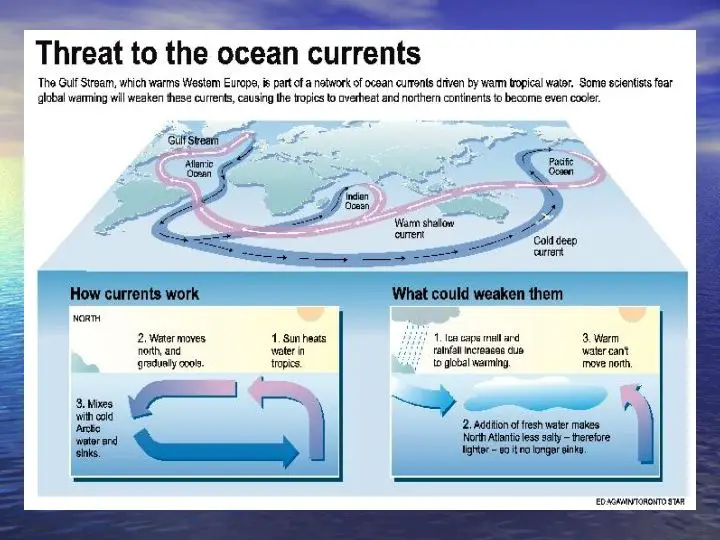There are affiliate links on this page. Read our disclosure policy to learn more.
 The major ocean streams or currents, of the world act as the
heating and cooling ducts of the earth, transporting heat from the equator
and taking it to the poles. All of these currents together, are the ocean
currents together are sometimes called the Ocean Conveyor due to this
effect. The direction, strength and paths of these currents is determined by
many factors, including the position of the land masses, rainfall and
salinity. Britain and northern Europe, for example, would be far colder than
they are today, if it were not for the Gulf Stream bringing warm water to
them. Constrast the climate of Britain withthat of interior Russia at the
same latitude, but without the warming effect of the Gulf Stream.
The major ocean streams or currents, of the world act as the
heating and cooling ducts of the earth, transporting heat from the equator
and taking it to the poles. All of these currents together, are the ocean
currents together are sometimes called the Ocean Conveyor due to this
effect. The direction, strength and paths of these currents is determined by
many factors, including the position of the land masses, rainfall and
salinity. Britain and northern Europe, for example, would be far colder than
they are today, if it were not for the Gulf Stream bringing warm water to
them. Constrast the climate of Britain withthat of interior Russia at the
same latitude, but without the warming effect of the Gulf Stream.
These include circular currents in the north and south of the Pacific and Atlantic Oceans, such as the Gulf Stream and one that travels around Antarctica. See the map at right. This highly simplified map of Atlantic currents shows the warmer surface currents (in red) and colder north Atlantic Deep Water (NADW, in blue). The thermohaline circulation heats the North Atlantic and Northern Europe. It extends right up to the Greenland and Norwegian Seas. Reproduced from Rahmstorf 1997.
The Gulf Stream, in the North Atlantic Ocean, carries warm water with a high concentration of salt from the equator up to the coast of America to Greenlan and then past Britain. Because warm water iswarm, it is less dense than the cooler water, so it tranvels near the surface. As it moves northward, it cools, increasing its density. It then begins to sink, and then begins it's return to the equator. Along the way, it has picked up nurients from the north and takes them south, where there is more biologic activity.
 If polar ice and glaciers which have hige amounts of earth's fresh water
locked up, begins to melt rapidly, then this meltwater can dilute the salty
equatorial water. This could make it less dense and stop it from sinking,
which , in turn, could stop the Gulf Stream completely.
If polar ice and glaciers which have hige amounts of earth's fresh water
locked up, begins to melt rapidly, then this meltwater can dilute the salty
equatorial water. This could make it less dense and stop it from sinking,
which , in turn, could stop the Gulf Stream completely.
At the end of the last ice age, scientists believe that the melting ice disrupted the ocean currents in the North Atlantic and caused a drop in temperature of almost 5 degrees. Even though the rest of the planet was warming up, the North Atlantic region remained in a cold period for almost 1300 years. The same thing happened around 8000 years ago, when the cooling lasted about a hundred years, and it could happen again today.
Plate tectonics in the movement of continents over the course of millions of years. This can affect both global and local patterns of climate and atmosphere-ocean circulation.
The position of the continents determines the geometry of the oceans and therefore influences patterns of ocean circulation. The locations of the seas are important in controlling the transfer of heat and moisture across the globe, and therefore, in determining global climate.
A recent example of tectonic control on ocean circulation is the formation of the Isthmus of Panama about 5 million years ago, which shut off direct mixing between the Atlantic and Pacific Oceans. This strongly affected the ocean dynamics of what is now the Gulf Stream and may have led to Northern Hemisphere ice cover. During the Carboniferous period, about 300 to 360 million years ago, plate tectonics may have triggered large-scale storage of carbon and increased glaciation. Geologic evidence points to a "megamonsoonal" circulation pattern during the time of the supercontinent Pangaea, and climate modeling suggests that the existence of the supercontinent was conducive to the establishment of monsoons.
The size of continents is also important. Because of the stabilizing effect of the oceans on temperature, yearly temperature variations are generally lower in coastal areas than they are inland. A larger supercontinent will therefore have more area in which climate is strongly seasonal than will several smaller continents or islands.
This page was updated on 25-Jan-2020